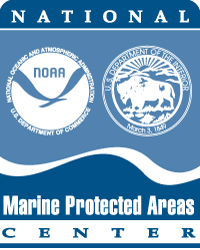What are cultural resources?
A Resource by the Marine Protected Areas Federal Advisory Committee (These statements do not necessarily reflect the positions of NOAA or the U.S. Government)
Below are examples of cultural resources that may be found in an MPA. These categories are not mutually exclusive and may overlap. Resources may be nautical (related to ships, vessels and watercraft), maritime (related to human seafaring) or cultural (related to cultural identity, such as religious, food and burial practices). A cultural landscape approach is a useful framework for understanding how cultural and environmental resources overlap and influence one another.
Maritime cultural resources
- Shipwrecks (e.g. USS Monitor) and sunken boats, large and small
- Airplanes and other wrecks of craft in the marine environment (e.g. the airship USS Macon and spacecraft artifacts off Cape Canaveral)
- Submerged land vehicles (e.g. amphibious vehicles, tanks, trucks)
- Inundated, sunken or eroding coastal structures such as lighthouses, forts, coastal defense structures, life saving stations, buildings, ports, and towns (e.g., sunken city of Port Royal, Jamaica)
- Submerged portions of docks and wharves
- Bridges
- Stories and history about a place or group’s maritime connection to the sea
- Landings used by ferries and boats
Indigenous cultural resources
- Traditional fish ponds (e.g. in Hawaii)
- Submerged cultural sites (e.g. occupation sites of indigenous ancestors, middens)
- Fishing weirs / fish traps
- Sites exposed on actively eroding shorelines such as habitations, burials
- Sites with importance religious or spiritual values (e.g. Papahānaumokuākea)
- Living marine resources with important cultural values (e.g. salmon and shellfish in the Pacific Northwest, coral in Papahānaumokuākea and Dugong in Japan)
- Stories and history about the tribe or group and its connection to the sea
Associated land-based resources that may be part of a cultural landscape:
- Coastal forts
- Ports and harbors
- Lighthouses and other navigational aids
- Docks / warehouses / port facilities
- Fish processing plants
- Shell and trash middens
- Whaling stations
 Marine Protected Areas
Marine Protected Areas